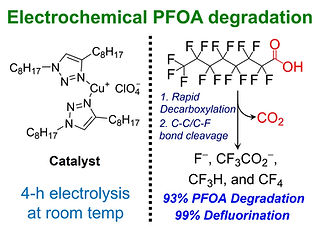Research
Our research group uses synthetic, mechanistic, and spectroscopic techniques to address one of the fundamental questions in renewable energy sciences: What are the guiding principles for the design of molecularly well-defined materials that serve as platforms for renewable energy capture, conversion and storage? Leveraging synthetic and molecular engineering techniques, we design and synthesize a series of model systems (i.e., organometallic complexes and multifunctional organic materials) and evaluate their performance in various applications, to elucidate the materials structure-function relationships and to understand the basic molecular interactions underpinning renewable energy storage.
I. Organic Materials-Based Redox Flow Battery

We develop organic/polymeric materials with tunable redox properties as both anolyte and catholyte for improved overall battery performance. Synthetic tools will be used to prepare a series of organic/polymeric materials with variations on redox property and solubility. Electrochemical and mechanistic studies will be performed to elucidate the structure-function relationships to provide information to design the next generation of materials with improved performance. Specific research aspects include:
-
membrane-free systems
-
special redoxmers with high potential, high solubility, etc.
-
non-aqueous electrolytes with enhanced ionic conductivity
II. Molecular Electrocatalytic Chemical Transformation

It is crucial to identify and implement efficient electrocatalysts to enhance reaction kinetics for chemical activation and conversion while improving product selectivity. We employ molecular engineering strategies to tailor molecular catalysts by modifying the primary, secondary, and tertiary functional spheres of the ligand scaffold, as well as the catalytic center.
III. Electrocatalytic Environmental Remediation

Perfluoroalkyl and polyfluoroalkyl substances (PFAS) comprise a family of over 3,000 anthropogenic compounds with atmospheric lifetimes exceeding 2,000 years. These compounds have been proven hazardous to both the environment and human health. We develop molecular electrocatalysts capable of rapidly activating C–F bonds to facilitate PFAS degradation. Specifically, our research focuses on: (1) designing homogeneous molecular electrocatalysts for C–F bond activation to establish catalyst structure–function relationships, and (2) exploring the substrate scope and identifying key factors governing defluorination.